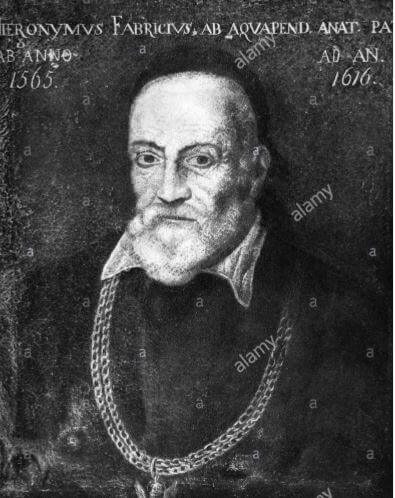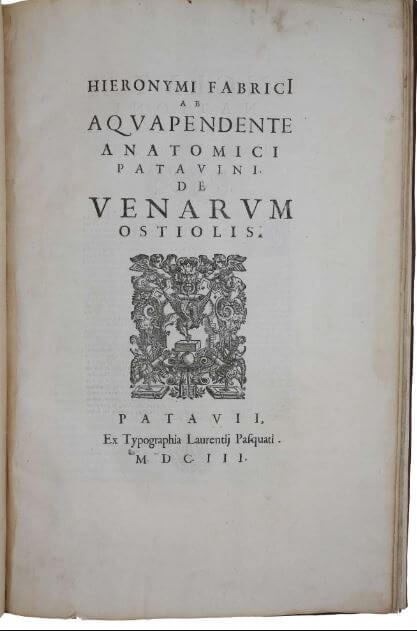The Bursa of Fabricius is a sac-like organ responsible for producing immunogenic B-lymphocytes and present only in the cloaca of birds. But the man who described it, far from being an obscure ornithologist, was a reputed professor of anatomy and surgery. Born in 1537 near Orvieto in central Italy, he had as a youngster a sharp wit and an excellent memory, and was sent to Padua, where he learned Greek, Latin, logic, and philosophy before studying medicine. He remained at the University of Padua after graduating and became assistant in anatomy to Gabriele Fallopio, demonstrating great aptitude in teaching and dissections. Padua at that time was a Venetian possession, part of the terra firma, and its prestigious anatomy department at the University, perhaps the best in Europe, had been the site of great advances under Andreas Vesalius, Realdo Colombo, and now Gabriele Fallopio. On the death of the latter in 1562, the Senate of Venice recognizing his talents appointed Fabricius professor of anatomy and surgery even though he was only twenty-five years old.
Fabricius held that chairmanship for almost fifty years, greatly advancing the teaching of anatomy, instructing during his lifetime an estimated ten thousand foreign students from all parts of Europe. Among these was William Harvey, who came to Padua in 1600, became one of his favorite students, and assisted him at dissections. By all accounts, it was his sojourn at Padua and his contact with Fabricius that inspired Harvey to formulate his theory of the circulation of the blood.
Yet Fabricius’s tenure at the University was not free from strife. At one time, in 1588, the students accused him of neglecting his teaching obligations, perhaps because of illness or possibly for spending excessive time on his research. He seems to have been a difficult person; was embroiled in an altercation with his German students for making fun of their accent in public; and was involved in controversies at the University by trying to prevent the appointment of academic rivals. But he also successfully intervened on behalf of a German student accused of homicide, and once provided another German student with a cadaver so that he could study his anatomy.
In the field of cardiovascular physiology Fabricius is remembered for publishing De venarum ostiolis, in which he describes the valves that prevent the backflow of blood in the veins (1579). Although these structures had been described earlier [by Charles Estienne of Paris in the liver (1545); Lusitanus and Canano of Ferrara in the azygos vein; and Jacques Sylvius again of Paris in the extremities in 1555] Fabricius at least deserves the credit of stimulating William Harvey to make further experiments showing that the blood circulates through both the pulmonary and the systemic circulations.
Fabricius has been styled the father of embryology, publishing in 1600 his treatise De formatu foetu (on the development of the fetus). He described the function of the placenta; studied the development of the egg, of the embryo in humans, also of sharks, snakes, and birds. As professor of anatomy, he studied the structure of the stomach, esophagus, intestines, eye, larynx, and ear. He described what later became known as the Sylvian Fissure, also the function of the larynx as an organ of speech and of the pupil of the eye. He made many improvements in surgery, publishing books and describing a great variety of surgical techniques and instruments, including a tracheostomy tube, and was physician and surgeon to famous personages. He received many honors. In 1595 the Senate of Venice built him a large auditorium (still named after him) to carry out public dissections. He became a knight of St. Mark and received a high annual salary that was continued after his retirement. He died in 1619 at the age of eighty-two.





Leave a Reply